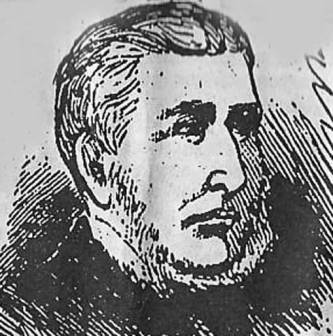
One of the most recognisable names in the Whitechapel murder case is that of Dr George Bagster Phillips, H Division’s divisional surgeon. Dr Phillips carried out the post mortem examinations of Annie Chapman, Elizabeth Stride, Kate Eddowes and Mary Jane Kelly. He famously noted of Chapman that:
‘the work was that of an expert- or one, at least, who had such knowledge of anatomical or pathological examinations as to be enabled to secure the pelvic organs with one sweep of the knife’.
This, and other remarks by doctors examining the victims, have led some to suggest that the murderer was a member of the medical profession (a ‘Dr Jack’) and has fuelled the ‘royal conspiracy’ theory that links the killings to Prince Albert Edward, the grandson of Queen Victoria, and Dr William Gull, her majesty’s surgeon.
For all sorts of reasons many (myself included) dismiss the idea that the killings were carried out by a doctor, but it is possible (probable even) that the murderer has some ‘knowledge of anatomical or pathological examinations’.
Dr Phillips started his career with H Division in 1865 and so these cases, in late September, are from the very beginning of his time in the East End. On Thursday 28 September that year there were three charges of attempted suicide heard at Worship Street Police court and Dr Phillips gave evidence in at least two of them.
James Munday (a 42 year-old french polisher) apparently swallowed oxalic acid in an attempt on his own life. He took the poison because his wife had left him but fortunately he had coughed it all up at the police station after his son had called for help. Dr Bagster Phillips (misreported as ‘Baxter’) told the court that Munday was lucky that he’d swallowed the poison on top of a ‘much larger quantity of some more palatable fluid’ (probably alcohol). His son’s quick think also helped. James was sorry for what he’d done and promised not to repeat it but the magistrate remanded him, just to be safe.
Caroline Cleal – in a separate incident – had also tried to kill herself with oxalic acid. Oxalic acid was used in a variety of applications mostly in cleaning products. It wasn’t as lethal as some other potions but in quantity it could cause death from kidney failure. Caroline was also a french polisher. She was also having problems at home and had bought a pennyworth of the acid at chemist in Whitecross Street. Dr Phillips told the court that such a small amount wouldn’t harm her and the magistrate remanded her for a week so that the police could make some enquiries and keep an eye on her.
Finally that day Ellen Read was brought up charged with trying to cut her own throat with a razor. PC Horne (178H) reported that he had been called to Read’s home in Dorset Street where he found her ‘bleeding frightfully from a wound in her throat’. Dorset Street was perhaps ‘the worst street’ in London and was where the body of Mary Kelly was to be found, brutally mutilated, in November 1888.
Ellen had been depressed her husband told the justice, and he’d tried to take her away for a few days to the country (probably hop picking in Kent, as many Eastenders did) but it hadn’t effected a change in her spirits. Ellen said nothing in court and the magistrate had little choice but the remand her as well.
What this shows us I think is that mental illness was endemic in Victorian London. Alcoholism, poverty, domestic violence and a range of other pressures undoubtedly contributed to making poor people’s lives incredibly challenging. Dr Phillips was provably called to more than one suicide or attempted suicide on a weekly basis and that, along with the street attacks, wife beatings, road traffic accidents, and more deliberate murders, must have inured him to violence by the late 1880s. Whether that prepared him for the horrors perpetrated that summer however, is debatable.
[from The Morning Post, Friday, September 29, 1865]
One thought on “‘She has been very low spirited lately’: The early casebook of the ‘Ripper’ surgeon reveals the extent of mental illness in London”